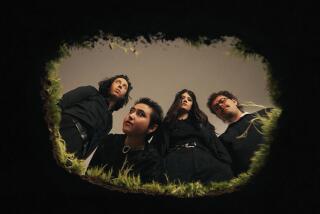The Name Doesn’t Do the Band Justice
- Share via
The math behind pop success is simple: Captivating bands are always greater than the sum of their parts. And, in the case of Garbage, that’s a pretty dynamic equation.
Front and center is Shirley Manson, a Scottish chanteuse armed with some of the sharpest, sultriest sentiments this side of the Pretenders’ first two albums. Surrounding her with music that’s an artful collision between catchy pop, gritty rock and alluring dance grooves are Midwestern multi-instrumentalists Steve Marker and Duke Erikson plus drummer/producer extraordinaire Butch Vig.
“I love melodies and hooks and classic pop song writing; when I hear that in a song, I try to really focus on that,” says Vig, who helped make those elements shine on albums by Nirvana and the Smashing Pumpkins (among others) before Garbage came together.
Adds Vig: “And, playing drums, I like the way the rhythm tracks feel. I also came from doing all these punk rock records, and I like noise and ambience. I went to film school and did a lot of experimental synthesizer tracks with strange background noise, and I love using that too. A lot of times I try to get all of that in a song.”
With Garbage’s self-titled 1995 debut, Vig and company blended those ingredients into a collection of edgy, appealing songs that struck a chord with a wide swath of music fans. The album yielded a string of hit singles (including “Stupid Girl” and “Only Happy When It Rains”) and went on to sell almost 2 million copies. Garbage earned three Grammy nominations for its efforts and toured for nearly two years--a surprising move for a group with such a studio-oriented sound.
Vig says the intensive concert schedule made a big impact on the recording of “Version 2.0,” last year’s smashing near-platinum follow-up to “Garbage.”
Though the four band members were seasoned musicians before joining forces, the live performances helped them bond as Garbage. Songs such as “I Think I’m Paranoid” and “Hammering in My Head” sizzle with all the familiar features that made “Garbage” a success, but the group delivers them with a more self-assured attitude that makes the 12 tracks a more powerful album.
As soon as “Version 2.0” hit the streets in May, Garbage hit the road again; the group has been touring ever since, racking up some 200 shows so far.
“The first challenge is making the songs sound good live,” Vig says, reflecting on the studio-stage dynamic. “We realized it was impossible to sound exactly like the album, so we’re a lot stronger in terms of how we interpret the songs. Some of them are quite radically different from the album, but they’re better in some ways.
“We look at them as two separate entities. Make the best album you can make, and then, when you go out and play live, interpret the songs to make the show work well.”
After Garbage finishes the final leg of the Alanis Morissette tour (which stops at the Anaheim Pond on Tuesday and Universal Amphitheater on Wednesday), it will take a short break before leaving for Europe to play festival shows all summer. The group then hopes to head for Australia and Japan before embarking on one more U.S. tour this fall.
Then, Vig says, it will be time to hit the studio again--with a slew of new experiences to add to the mix.
Shifting from festival headliner to arena opener hasn’t been easy, but then, Garbage is a band that thrives on challenges.
“We had one bad show,” Vig says of the current tour with Morissette. “The first show in Cincinnati. We played a real arty show because we played what we wanted to. We’d just come back from two months in Europe, where we headlined these massive arenas. It was amazing for us to play to 10,000 kids every night. In Madrid they sang the lyrics to every song at the top of their lungs--twice as loud as the PA. It was incredible. And then in Cincinnati it was a disaster.
“We realized we had to totally change our focus. We can’t meander through a set because you’ve only got 40 minutes to show what you can do. We have to put the pedal to the metal from the second we hit the stage.
“There’s a pretty good contingent [at Morissette’s shows] to see us, but we take it as a challenge that we’re playing to a new audience and we have to win them over,” Vig says. “It’s easy to play the same environment every time, play to people who are your hard-core fans. We did that all last year, and we feel like we need to play in front of new people now.”
More to Read
The biggest entertainment stories
Get our big stories about Hollywood, film, television, music, arts, culture and more right in your inbox as soon as they publish.
You may occasionally receive promotional content from the Los Angeles Times.







